Surface Characterization of Modified Electrodes Based on 4-(Azulen-1-yl)-2,6-bis((E)-2-(thiophen-2-yl)vinyl)pyridine
Abstract
1. Introduction
2. Materials and Methods
3. Results
3.1. Sample Preparation
3.2. SEM and EDX Results
3.3. AFM Results
3.4. FTIR Results
3.5. Fluorescence Studies
3.6. Electrochemical Evidence for Film Formation
4. Discussion
5. Conclusions
Supplementary Materials
Author Contributions
Funding
Data Availability Statement
Acknowledgments
Conflicts of Interest
References
- Shoji, T.; Yokoyama, R.; Ito, S.; Watanabe, M.; Toyota, K.; Yasunamid, M.; Morita, N. Synthesis of heteroarylazulenes: Transition metal free coupling strategy of azulene with heterocycles. Tetrahedron Lett. 2007, 48, 1099–1103. [Google Scholar] [CrossRef]
- Shoji, T.; Ito, S. The Preparation and Properties of Heteroarylazulenes and Hetero-Fused Azulenes. Adv. Heterocycl. Chem. 2018, 126, 1–54. [Google Scholar]
- Răzuș, A.C.; Bîrzan, L. Synthesis of azulenic compounds substituted in the 1-position with heterocycles. Mon. Chem. 2019, 150, 139–161. [Google Scholar] [CrossRef]
- Shoji, T.; Okujima, T.; Ito, S. Development of Heterocycle-Substituted and Fused Azulenes in the Last Decade (2010–2020). Int. J. Mol. Sci. 2020, 21, 7087. [Google Scholar] [CrossRef]
- Răzuș, A.C. Azulene Moiety as Electron Reservoir in Positive Charged Systems; Short Survey. Symmetry 2021, 13, 526. [Google Scholar] [CrossRef]
- Shoji, T.; Yamazaki, A.; Katoh, R.; Shimamura, K.; Sakai, R.; Yasunami, M.; Okujima, T.; Ito, S. Synthesis, Reactivity, and Properties of Benz[a] azulenes via the [8+2] Cycloaddition of 2H-Cyclohepta[b]furan-2-ones with an Enamine. J. Org. Chem. 2022, 87, 5827–5845. [Google Scholar] [CrossRef]
- Ou, L.; Zhou, Y.; Wu, B.; Zhu, L. The unusual physicochemical properties of azulene and azulene-based compounds. Chin. Chem. Lett. 2019, 30, 1903–1907. [Google Scholar] [CrossRef]
- Buică, G.-O.; Bîrzan, L.; Popescu (Mandoc), L.-R.; Ivanov, A.A.; Ungureanu, E.-M. Thermodynamics of interactions between lead(II) and cadmium(II) ions and azulene-based complexing polymer films. J. Solid State Electrochem. 2016, 20, 401–411. [Google Scholar] [CrossRef]
- Heitzmann, M.; Bucher, C.; Moutet, J.-C.; Pereira, E.; Rivas, B.L.; Royal, G.; Saint-Aman, E. Characterization of metal cations-complexing polymer films interactions followed with anodic stripping voltammetry. J. Electroanal. Chem. 2007, 610, 147–153. [Google Scholar] [CrossRef]
- Heitzmann, M.; Bucher, C.; Moutet, J.-C.; Pereira, E.; Rivas, B.L.; Royal, G.; Saint-Aman, E. Complexation of poly(pyrrole-EDTA like) film modified electrodes: Application to metal cations electroanalysis. Electrochim. Acta 2007, 52, 3082–3087. [Google Scholar] [CrossRef]
- Buică, G.-O.; Lazăr, I.-G.; Saint-Aman, E.; Tecuceanu, V.; Dumitriu, C.; Ivanov, A.A.; Stoian, A.B.; Ungureanu, E.-M. Ultrasensitive modified electrode based on poly (1 H-pyrrole-1-hexanoic acid) for Pb (II) detection. Sens. Actuators B: Chem. 2017, 246, 434–443. [Google Scholar] [CrossRef]
- Gutierrez, A.G.P.; Gutierrez, S.; Ordaz, A.A.; Griveau, S.; Zagal, J.H.; Bedioui, F. Preparation and Characterization of Modified Electrodes Based on Carbon Nanotubes/Pyrrole/Cobalt Phthalocyanine for the Development of Hybrid Materials for the Electrochemical Activation of 2-mercaptoethanol. ECS Trans. 2008, 15, 133–141. [Google Scholar] [CrossRef]
- Wajs, E.; Fernández, N.; Fragoso, A. Supramolecular biosensors based on electropolymerised pyrrole–cyclodextrin modified surfaces for antibody detection. Analyst 2016, 141, 3274–3279. [Google Scholar] [CrossRef] [PubMed]
- Oliveira, R.D.; Santos, C.S.; Garcia, J.R.; Vidotti, M.; Marchesi, L.F.; Pessoa, C.A. IR drop studies of poly(aniline)-based modified electrodes. J. Electroanal. Chem. 2020, 878, 114662. [Google Scholar] [CrossRef]
- Lete, C.; Lupu, S.; Marin, M.; Badea, M. New composite materials used in the phenol electroanalysis. Part I. poly(azulene)/Prussian blue and Prussian blue/poly(azulene) films. Rev. Roum. Chim. 2010, 55, 335–340. [Google Scholar]
- Buică, G.-O.; Ungureanu, E.-M.; Bîrzan, L.; Răzuș, A.C.; Mandoc, L.-R. Voltammetric sensing of lead and cadmium using poly(4-azulen-1-yl-2,6-bis (2-thienyl)pyridine) complexing films. J. Electroanal. Chem. 2013, 693, 67–72. [Google Scholar] [CrossRef]
- Lazăr, I.-G.; Diacu, E.; Ungureanu, E.-M.; Buică, G.-O.; Bîrzan, L.; Arnold, G.-L. Modified electrodes based 2,6-bis((E)-2-(thiophen-2-yl)-4-(4,6,8-trimethylazulen-1-yl)pyridine for heavy metals sensing. UPB Sci. Bull. Ser. B 2017, 79, 23–26. [Google Scholar]
- Oprișanu, A.; Lazăr, I.-G.; Pop, M.D.; Ungureanu, E.-M.; Isopescu, R.; Bîrzan, L. Polyazulene Based Materials For Heavy Metal Ions Detection. IOP Conf. Ser. Mater. Sci. Eng. 2017, 68, 2215–2218. [Google Scholar]
- Brotea, A.-G.; Matica, O.-T.; Musina (Borsaru), C.E.; Ungureanu, E.-M. Advanced materials based on 4-(azulen-1-yl)-2,6-bis((E)-2-(thiophen-2-yl)vinyl)pyridine. UPB Sci. Bull. Ser. B 2022, 84, 53–62. [Google Scholar]
- Ciocîrlan, O.; Ungureanu, E.-M.; Vasile (Corbei), A.-A.; Ștefaniu, A. Properties Assessment by Quantum Mechanical Calculations for Azulenes Substituted with Thiophen-or Furan-Vinyl-Pyridine. Symmetry 2022, 14, 354. [Google Scholar] [CrossRef]
- Wang, B.-C.; Lin, Y.-S.; Chang, H.; Wang, P.-Y. Theoretical studies of azulene and its derivatives. Can. J. Chem. 2000, 78, 224–232. [Google Scholar] [CrossRef]
- Korichi, H.; Zouchoune, F.; Zendaoui, S.-M.; Zouchoune, B.; Saillard, J.-Y. The Coordination Chemistry of Azulene: A Comprehensive DFT Investigation. Organometallics 2010, 29, 1693–1706. [Google Scholar] [CrossRef]
- Mirzaei, M.S.; Taherpour, A.A.; Wentrup, C. Azulene–Naphthalene, Naphthalene–Naphthalene, and Azulene–Azulene Rearrangements. J. Org. Chem. 2022, 87, 11503–11518. [Google Scholar] [CrossRef] [PubMed]
- Kreuter, F.; Tonner, R. Surface functionalization with nonalternant aromatic compounds: A computational study of azulene and naphthalene on Si(001). J. Phys. Condens. Matter 2021, 33, 444003. [Google Scholar] [CrossRef] [PubMed]
- Birzan, L.; Cristea, M.; Draghici, C.; Tecuceanu, V.; Hanganu, A.; Ungureanu, E.-M.; Razus, A.C. 4-(Azulen-1-yl) six-membered heteroaromatics substituted in 2- and 6- positions with 2-(2-furyl)vinyl, 2-(2-thienyl)vinyl or 2-(3-thienyl)vinyl moieties. Tetrahedron 2017, 73, 2488–2500. [Google Scholar] [CrossRef]
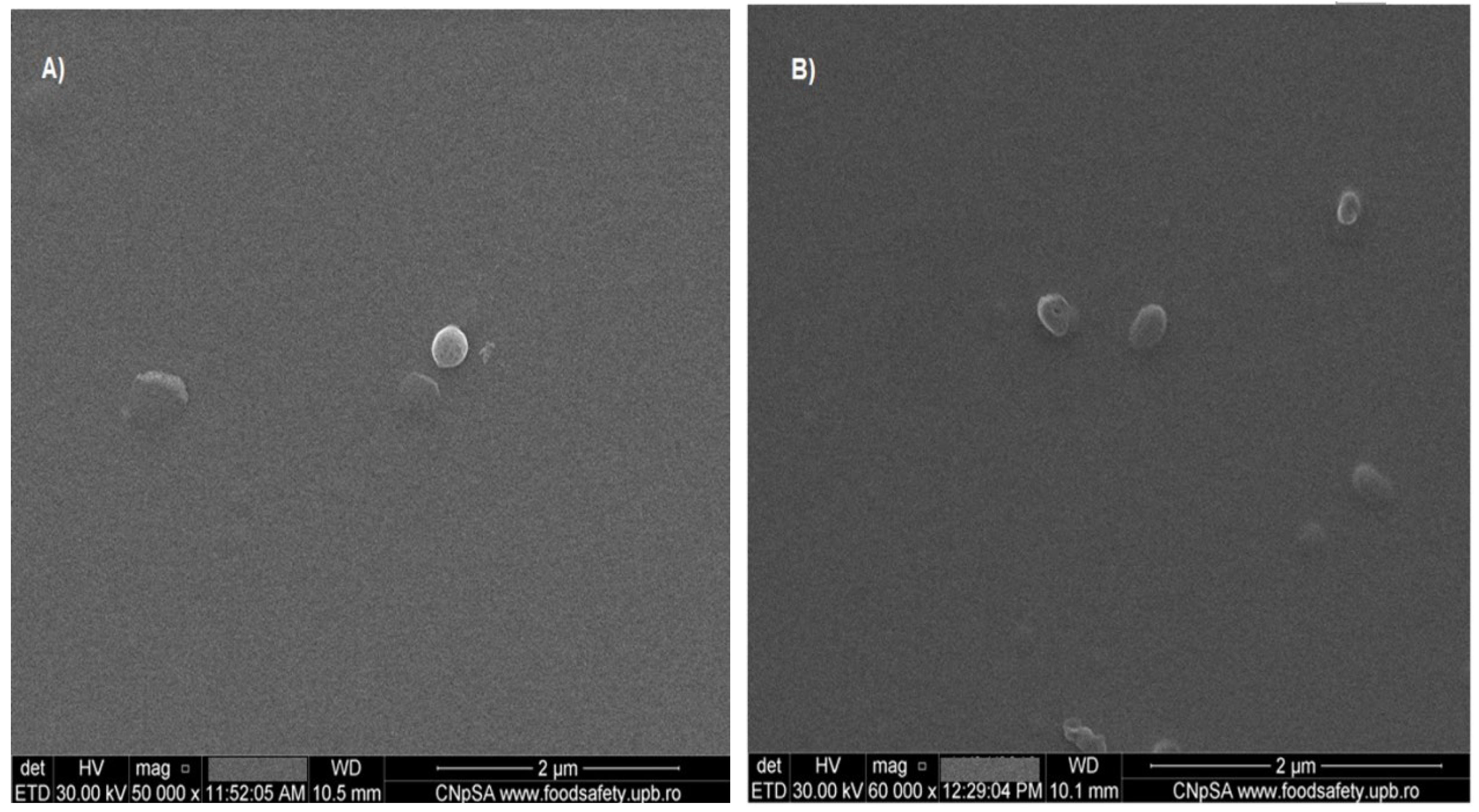

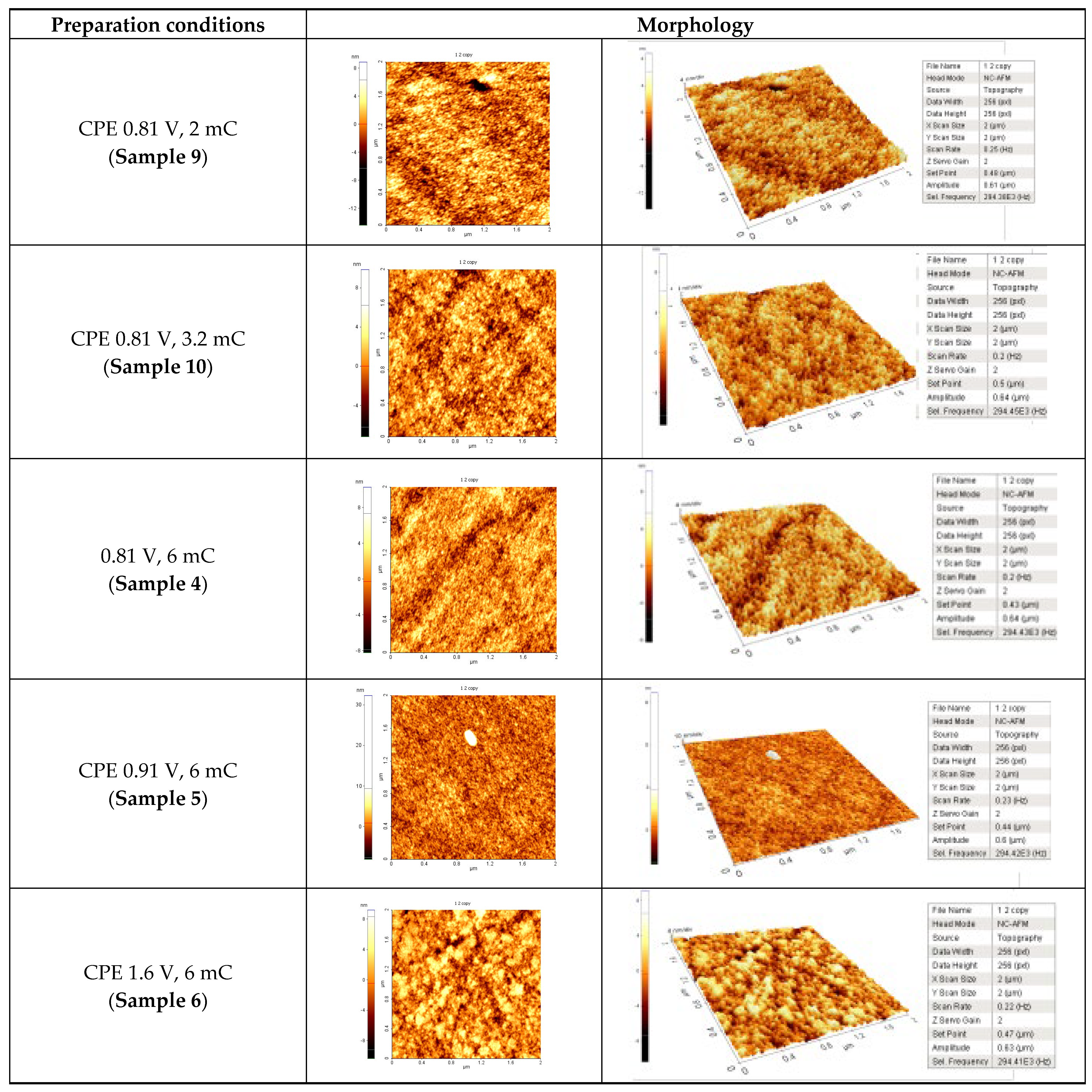
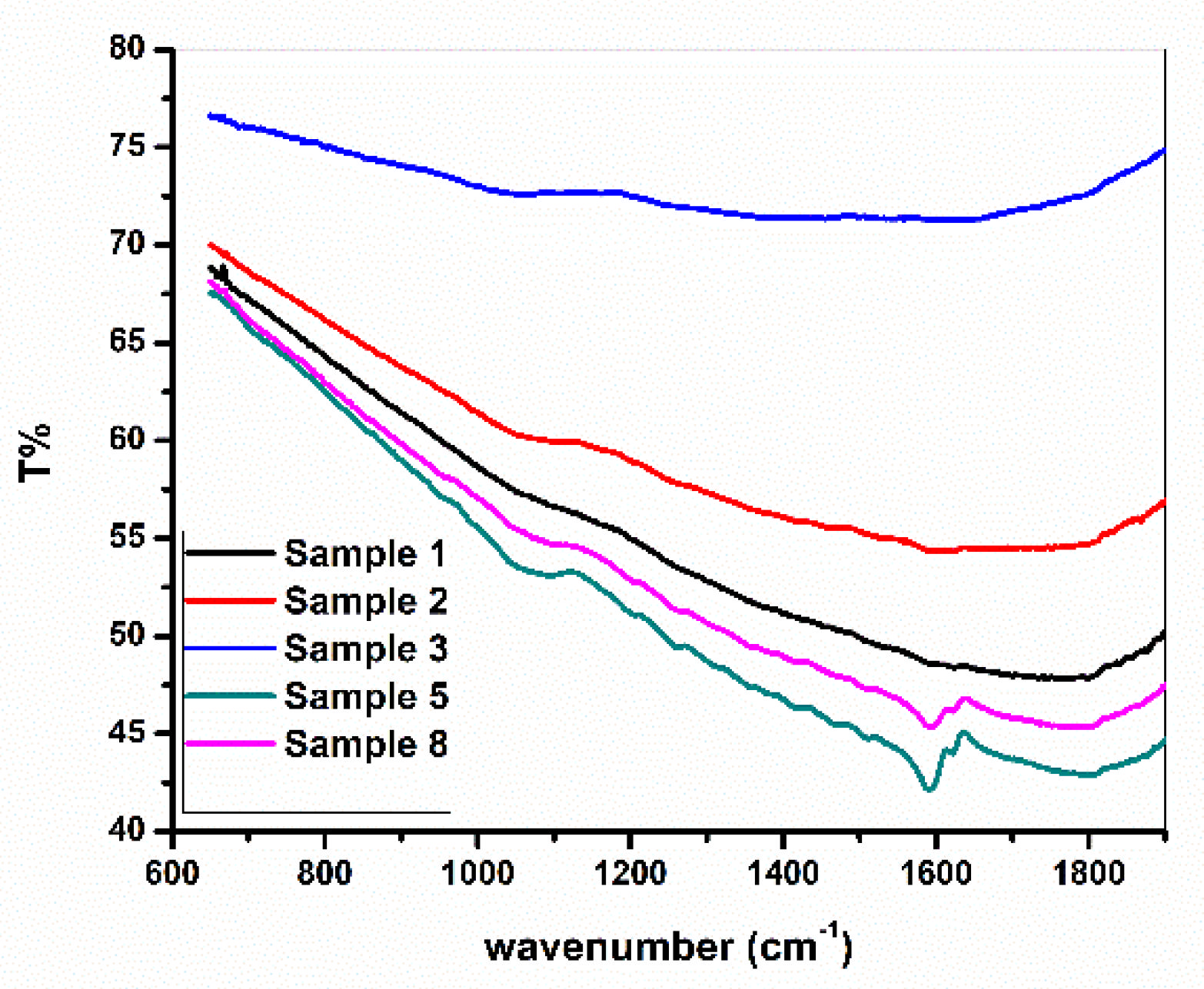
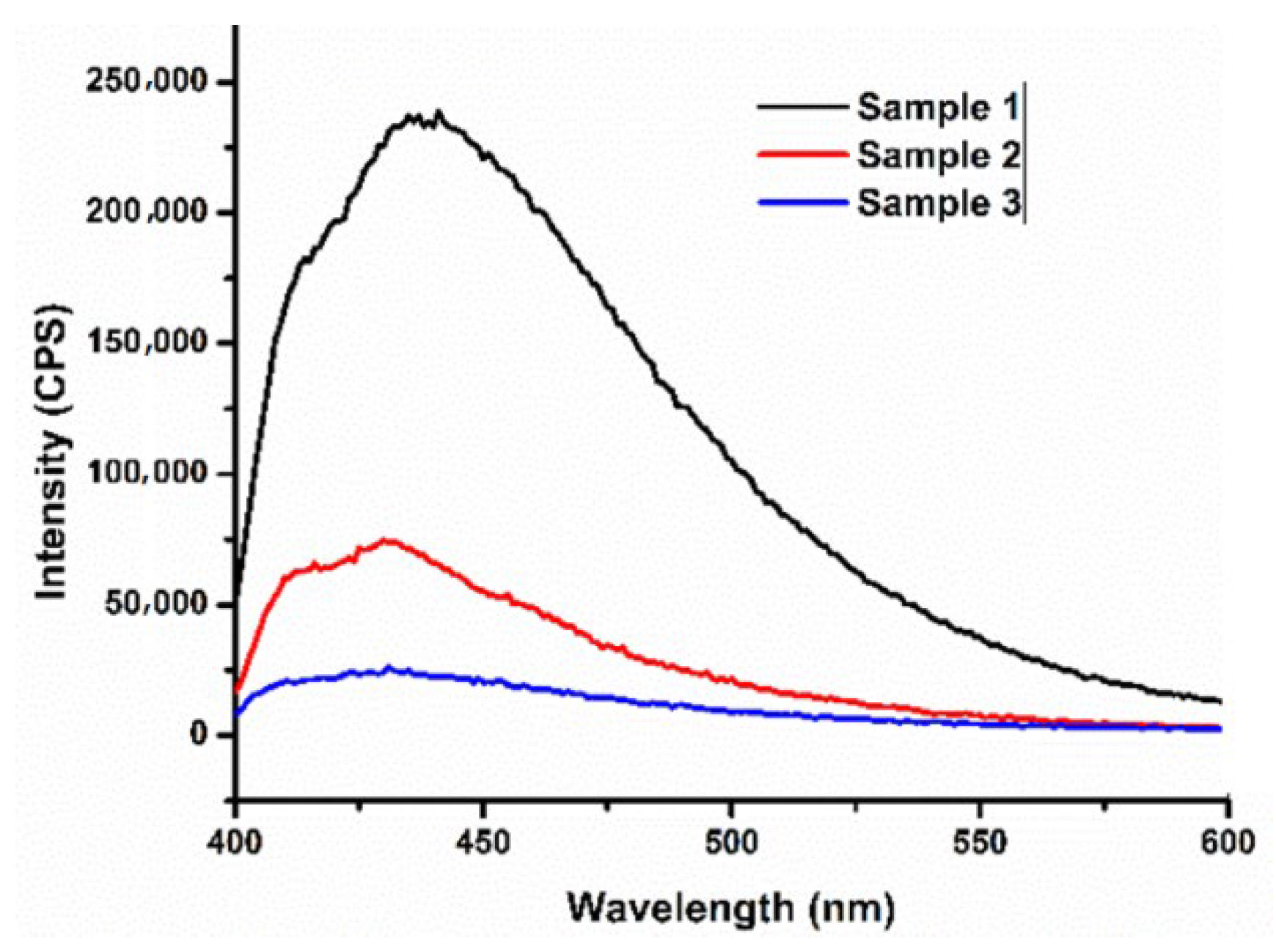
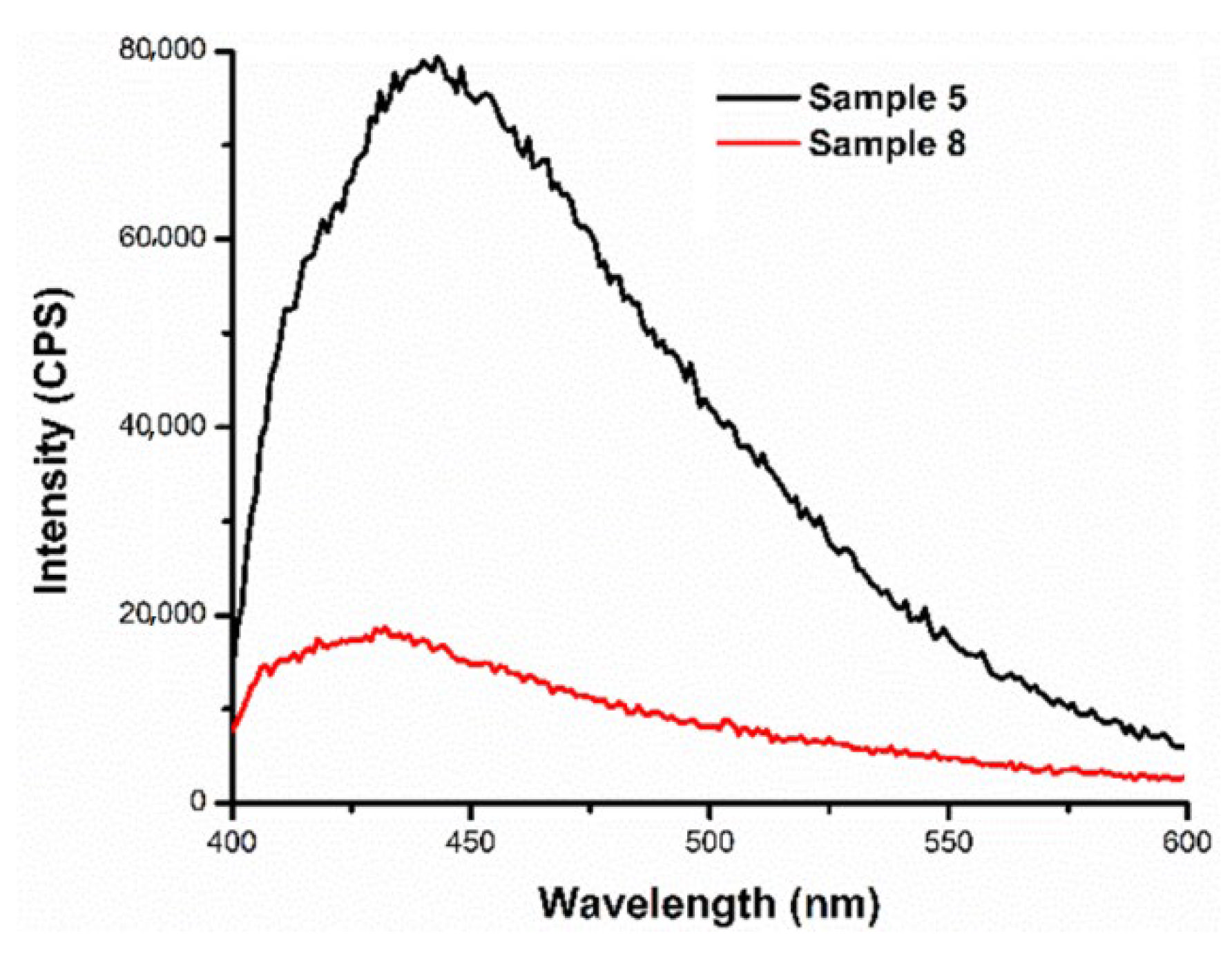
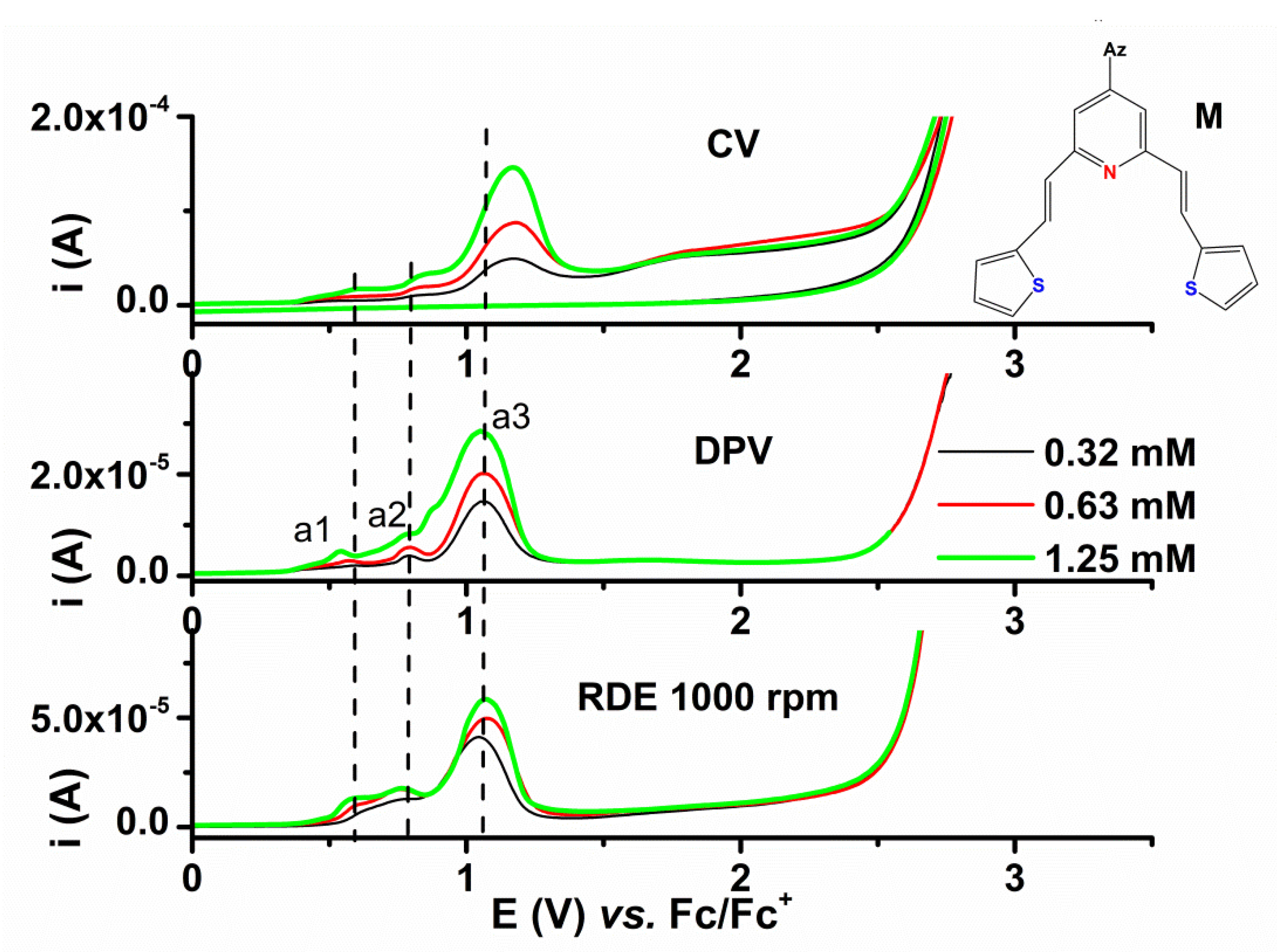

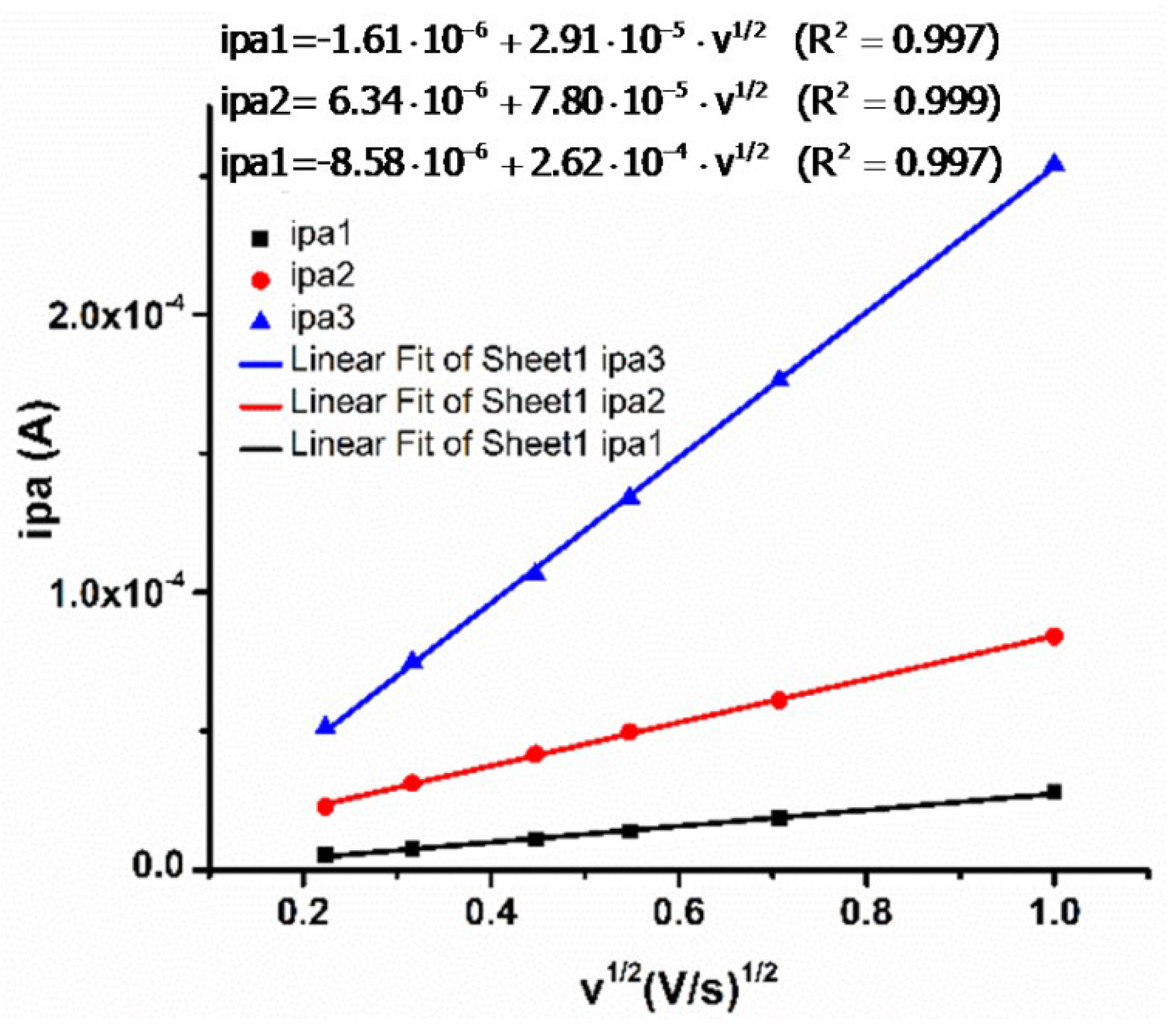
| Sample | Film Formation | Film Colour |
|---|---|---|
| 1 | Scanning 0.81 V 15 scans | Blue |
| 2 | Scanning 0.91 V 15 scans | Turquoise |
| 3 | Scanning 1.6 V 10 scans | Brown |
| 4 | CPE 0.81 V 6 mC | Emerald green |
| 5 | CPE 0.91 V 6 mC | Blue |
| 6 | CPE 1.6 V 6 mC | Gray |
| 7 | CPE 0.91 V 2 mC | Dark turquoise |
| 8 | CPE 0.91 V 3.2 mC | Greenish yellow |
| 9 | CPE 0.81 V 2 mC | Navy blue |
| 10 | CPE 0.81 V 3.2 mC | Yellow-green |
| Sample | Film Formation Parameters | SEM and EDX Characteristics |
|---|---|---|
| 1 | Scanning 0.81 V; 15 cycles | Unstructured organic film. EDX does not highlight either S or N. |
| 2 | Scanning 0.91 V; 15 cycles | Nanometric structure, size 3–11 nm. EDX does not highlight either S or N. |
| 3 | Scanning 1.6 V; 10 cycles | Nanometric structure, size 8.5–22 nm (Figure S2). Structured organic film. EDX does not highlight either S or N. |
| 5 | CPE 0.91 V; 6 mC | Uniform film with rare nanoclusters (150–250 nm) (Figure 1a). EDX reveals the presence of S, O, and Cl. |
| 8 | CPE 0.91 V; 3.2 mC | Uniform film with nanoclusters (100–200 nm) (Figure 1b). EDX reveals the presence of S, O, and Cl. |
| Sample | Film Formation Parameters | RMS at 40 × 40 μm2 | RMS at 2 × 2 μm2 |
|---|---|---|---|
| 9 | CPE 0.81 V; 2 mC | 2.4 | 2.0 |
| 10 | CPE 0.81 V; 3.2 mC | 5.2 | 2.0 |
| 4 | CPE 0.81 V; 6 mC | 4.2 | 2.4 |
| 5 | CPE 0.91 V; 6 mC | 35.8 | 2.2 |
| 6 | CPE 1.6 V; 6 mC | 2.9 | 2.5 |
| Sample | Remarks | λmax (nm) | Intensity (cps) | FWHM (nm) |
|---|---|---|---|---|
| 1 | - thin film with nanometric particles with homogeneous dimensional distribution - wavelength = 403–491 nm | 438 | 238,000 | 80 |
| 2 | - thin film with nanometric particles with homogeneous dimensional distribution - wavelength = 402–488 nm | 430 | 75,000 | 60 |
| 3 | - thin film with nanometric particles with homogeneous dimensional distribution - wavelength = 402–483 nm | 430 | 26,000 | 70 |
| 5 | - thin film with nanometric particles with homogeneous dimensional distribution - wavelength = 401–477 nm | 442 | 80,000 | 80 |
| 8 | - thin film with nanometric particles with a wide range of dimensions - wavelength = 408–522 nm | 431 | 19,000 | 75 |
Publisher’s Note: MDPI stays neutral with regard to jurisdictional claims in published maps and institutional affiliations. |
© 2022 by the authors. Licensee MDPI, Basel, Switzerland. This article is an open access article distributed under the terms and conditions of the Creative Commons Attribution (CC BY) license (https://creativecommons.org/licenses/by/4.0/).
Share and Cite
Chilibon, I.; Păun, A.-M.; Vasiliu, C.; Diacu, E.; Isopescu, R.; Ungureanu, E.-M. Surface Characterization of Modified Electrodes Based on 4-(Azulen-1-yl)-2,6-bis((E)-2-(thiophen-2-yl)vinyl)pyridine. Symmetry 2022, 14, 2506. https://doi.org/10.3390/sym14122506
Chilibon I, Păun A-M, Vasiliu C, Diacu E, Isopescu R, Ungureanu E-M. Surface Characterization of Modified Electrodes Based on 4-(Azulen-1-yl)-2,6-bis((E)-2-(thiophen-2-yl)vinyl)pyridine. Symmetry. 2022; 14(12):2506. https://doi.org/10.3390/sym14122506
Chicago/Turabian StyleChilibon, Irinela, Adina-Maria Păun, Cristina Vasiliu, Elena Diacu, Raluca Isopescu, and Eleonora-Mihaela Ungureanu. 2022. "Surface Characterization of Modified Electrodes Based on 4-(Azulen-1-yl)-2,6-bis((E)-2-(thiophen-2-yl)vinyl)pyridine" Symmetry 14, no. 12: 2506. https://doi.org/10.3390/sym14122506
APA StyleChilibon, I., Păun, A.-M., Vasiliu, C., Diacu, E., Isopescu, R., & Ungureanu, E.-M. (2022). Surface Characterization of Modified Electrodes Based on 4-(Azulen-1-yl)-2,6-bis((E)-2-(thiophen-2-yl)vinyl)pyridine. Symmetry, 14(12), 2506. https://doi.org/10.3390/sym14122506






